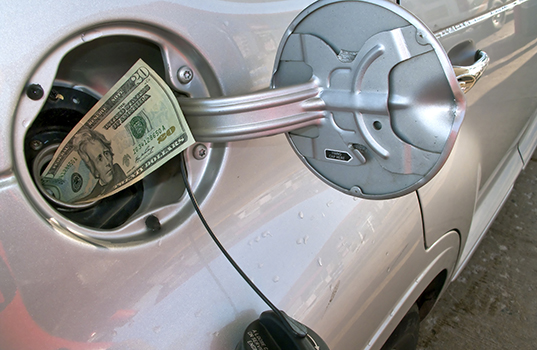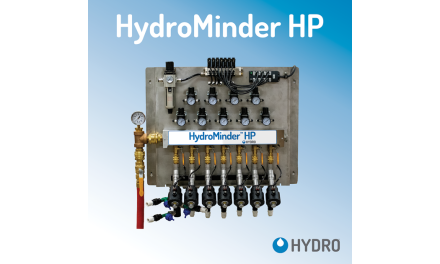By Keith Reid
“I’m not just the president of Hair Club for Men, I’m also a client!” This line from Sy Sperling’s 1986 commercial jumped to mind when I began writing this Policy Brief. My version would be: “I’m not just writing about Illinois’ expansive new motor fuels taxes; I get shafted by it every time I fill the tank!” So, use this as a bit of disclosure to the fact that I may not be completely impartial where this issue is concerned.
The fracking revolution created an opportunity to generate fuel tax revenue that would have been more difficult previously. We had constant price volatility, high (and rising) inflated oil prices and the resulting high refined fuel prices going into the recession of 2008. Then, prices bottomed out, and as we moved out of the recession the enormous production potential of domestic fracking ensured that while prices would recover somewhat the upside would largely be capped.
Politicians apparently noticed that consumers became, at some level, numb to paying more (within limits) for motor fuels during the bad years. There seems to be a belief that if any fuel tax increase is not overly oppressive, you have fertile ground to harvest revenue.
Granted, the surface justification for fuel tax increases has some validity. Our ground transportation infrastructure, typically funded by motor fuel taxes, has been neglected and revenue is lacking to turn that around. This results in real costs to society. There are a variety of reasons for this shortfall. Vehicles have become more fuel-efficient, there has been at least some penetration of electric and hybrid vehicles and in recent years (2008 – 2015) demand had been relatively flat. Less fuel to tax results in less funds to use.
A total of 12 states recently passed increases to their motor fuel taxes. Most of them are under two cents per gallon (and generally well under). For gasoline, California comes in with a 5.6 cent increase. Ohio with a 10.5 cent increase. In my home state, Illinois, the increase was a whopping 19 cents per gallon for gasoline and 24 cents per gallon for diesel. Included was an automatic tax increase tied to inflation. Similar tax increases were deployed for alternative fuels like propane.
To be fair, the previous 19 cent gasoline tax dated back to 1990. The doubling of the tax to 38 cents per gallon more than makes up for that lapse. The tax increase is part of the 2020 state budget and supports an included a $45-billion Illinois infrastructure plan pushed by the new Democratic Governor J.B. Pritzker. Ironically, Pritzker is a billionaire who notably tried to avoid paying $331,000 in taxes on a Chicago property by tearing five toilets out of the mansion to get it classified as “uninhabitable.”
The tax increases were pushed through by Democratic supermajorities in both the state house and senate. I should note that in my observation Illinois is generally bipartisan where taxes and spending are concerned. Except for the previous Republican Governor Bruce Rauner, who’s “Turnaround Agenda” saw stiff resistance and resulted in no budget for two years of his term, the Illinois GOP seems to be more interested in getting their slice of the pie rather than trying to make the pie significantly smaller. The ILGOP generally supported Pritzker’s 2020 budget.
As the Illinois Policy Institute notes, the tax increase, which became effective July 1, pushes Illinois to the second-highest gas taxes in the nation.
But it doesn’t stop there. On the surface, the state fuel taxes are not necessarily far out of line with some neighboring states, Indiana most notably. However, municipalities in Cook County, such as Chicago, can increase their taxes by three cents, and other “collar counties” around Chicago can increase their taxes by between four and eight cents per gallon. As the Illinois Policy Institute notes: Illinois is one of just seven states where drivers pay layers of both general sales taxes and special excise taxes on gasoline at the state and local levels. Those multiple layers mean drivers filling up in Chicago, for example, will pay 96 cents in taxes and fees on a $2.46 gallon of gasoline—an effective tax burden of 39%.
The expected costs to motorists start at $100 per year, with two to three times that figure being noted as possible depending on a range of factors.
But wait, there’s more! Other exciting revenue plays include:
- Vehicle registration fees will increase by about 50 percent from $98 to $148.
- The owners of electric vehicles will see $248 in new fees.
- The Illinois minimum wage will ramp up from $8.25 to $15 by 2025 at about $1 per year.
- The cigarette tax will go up by $1, from $1.98 to $2.98 a pack.
- E-cigarettes will be taxed at a rate of 15 percent.
When combined with the last three items, the fuel tax represents a disaster for Illinois fuel retailers.
“When the difference on the border was 8 – 10 cents, it wasn’t too bad, but now we are expecting a 50% or higher drop in volume,” said Bill Fleischli, executive vice president of the Illinois Petroleum Marketers Association/Illinois Association of Convenience Stores, when I interviewed him recently. “That should extend, to some degree, as far as 50 miles from the border. And when you combine that with a $1 per pack increase in the cigarette tax and the increase in the minimum wage and an increase in the sales tax—this is devastating.”
He noted several quality stations in a border county have already been posted for sale. He expects many stations to close, perhaps hundreds, as a result of these developments. As this Policy Brief was being written, the post-increase price differential between Illinois and neighboring states ranged between 20 cents less per gallon (Indiana) and 50 cents less per gallon (Missouri), according to AAA. Fleischli’s concerns are further reinforced by numerous local television stories covering the exodus of customers to stations across the border the day of the tax increase.
For commercial fleets the news is also troublesome. Local and regional fleets will see a significant cost increase on the fuel side, but there has been a repeal of a 14.35 percent commercial distribution fee for vehicles that weigh between 8,001 and 80,000 pounds. That should save hundreds of dollars per vehicle, though other registration fees have increased that partially offset the savings.
Over the road truckers will generally have incentives to bypass Illinois as a fueling location whenever possible. As this article was being written, the price differential on diesel ranged from 3 cents less (Indiana) to 34 cents less (Missouri), with at least a 20-cent difference compared to Iowa and Wisconsin, according to Truckmiles.com.
The cigarette tax is especially troublesome for border stations. Data from the Commission on Government Forecasting and Accountability shows just how troublesome. Illinois’ $2.98 cigarette tax compares to its border states as follows: Indiana (99.5 cents); Kentucky ($1.10); Iowa ($1.36); and Wisconsin ($2.52). The difference between Illinois and Missouri is the starkest. At just 17 cents tax per pack in Missouri, it will cost $28 more for a carton of cigarettes in Illinois.
But what about the money?
The push for increases in federal and state fuel taxes would have greater validity if the money was well spent and fully devoted to infrastructure needs. Unfortunately, that is not the case.
The federal tax on gasoline is 18.40 cents per gallon and diesel is 24.40 cents. The U.S. Energy Information Administration noted that as of January 1, 2019, the average of total state taxes is 28.68 cents per gallon for gasoline and 30.43 cents for diesel. These taxes are supposed to be set aside to support the infrastructure associated with highways and other road transportation needs. However, that is typically only partially true.
As the libertarian Cato Institute notes, in 2016 the states raised $44 billion, supposedly for highway use, but diverted an average of 24% to other projects such as urban mass transit (and many other projects that have little if anything to do with transportation, such as squirrel sanctuaries). In Illinois that figure was 30%.
The Illinois fuel tax hike is expected to generate an additional $1.2 billion. That will be split between the state and local governments. According to Pritzker in a press conference: “Every dollar that is coming in from the motor fuel tax is going into a lock box that only goes to roads and bridges and our surface transportation needs across the state, so people know that that money will be spent well.” Notably the press conference took place at the Chicago Transit Authority headquarters and not some Illinois highway overpass. Nearly $5 billion will go to transit agencies like the CTA and Metra.
Fleischli noted that the last two Illinois budgets saw some $350 million siphoned from the road fund, such as the $30 million used for emission testing. While some of the varied motor fuel taxes are mandated, the motor fuels sales tax, for example, is not.
An Illinois Policy Institute analysis found at least $1.4 billion of waste and pork spending in the $45 billion infrastructure plan that accompanied the tax increases. It cited funding for pickleball courts, swimming pools and vague grants to be handed out by politicians and well-connected insiders. On the last part, the savvy Illinois resident is not the least bit surprised. Even for the clearly needed projects few bulldozers move, or concrete gets poured without the appropriate political connections and “beak wetting.”
All of this might be palatable to an Illinois resident if the money diversions and waste and graft at least partially addressed Illinois’ terrible financial situation. All of Illinois’ five state pension funds are grossly underfunded and cannot be revised without amending the state constitution. The funding that has occurred has featured significant and questionable borrowing in recent years. The state’s credit rating is the worst in the country and is approaching “junk” status. There hasn’t been an honestly balanced budget since 2011.
The 2020 budget itself is not honestly balanced, relying on “optimistic” revenue projections. It’s the highest spending budget ever. Even the revenues raised by legalizing marijuana and gambling tend to support new spending rather than fix serious vulnerabilities.
So, what to expect? In a perfect world these overreaches would generate a backlash that would see a political change and some motivation to support fiscal sanity before it’s too late. I doubt that will be the case. My predictions:
- Residents’ current anger will subside, and Illinois citizens will get used to the taxes and continue as usual, thus furthering the state’s decline.
- Illinois residents who think they will be more on the receiving side will outnumber those on the giving side and will approve the proposed progressive tax plan next year. It also opens the door for unlimited increases in the corporate tax. The middle class will find out they have a lot more in common with those “millionaires” than they thought.
- Fuel and cigarette tax revenues will not reach the expected goals as those who can cross state lines for cheaper alternatives will, but likely enough people will be trapped far enough away from the border to keep the increases from being totally ineffective. Expect more tax increases to follow.
- Volumes will drop at stations near the border and it will be a disaster for those operators.
- Local and regional fleets will have to tighten the belt.
- The mass exodus of citizens and businesses already underway from Illinois to other states will only increase. Your author has already started to investigate some nice areas in Wisconsin.
Any Chicago sports fan would understand my cynical pessimism. However, miracles do happen. The Bears did get into a couple of Super Bowls in my lifetime, winning one with one of the best teams to play the sport. And the Cubs won a World Series, reportedly causing freezing temperatures in a traditionally warm netherworld. So, we’ll see….









